Respiratory Survey 2014
Respiratory Survey
- By Joseph Duffy
- Mar 01, 2014
With Round Two of competitive bidding being implemented in 91 metropolitan areas in mid-2013 and Round One re-compete rates going into effect in nine competitive bidding areas early this year, CMS’s controversial bidding program is once again on the forefront of RSM’s Fifth Annual Respiratory and Sleep Survey.
For the fourth year in a row, competitive bidding is the single biggest challenge facing the homecare industry, according to 41 percent of respondents. This is just slightly under last year’s 43.6 percent, but it seems more survey takers took the time with this year’s survey to sound off about life under a barrage of reimbursement cuts. A provider sums up the frustration competitive bidding has contributed to one of the survey’s running themes: patient care.
“I miss my old job!” one survey respondent replied. “I want to see my patients and not be doing paperwork all the time. I have been doing this for more than 20 years. I miss contact with patients and I am tired of being overworked by just trying to get paid. I know if we do not make money we will not be here to help anyone, so we continue on. I just want to see my patients and help them understand how to manage their disease. I try to stay hopeful, but it is hard. Sorry to be so negative but it is hard to stay positive during these tough times.”
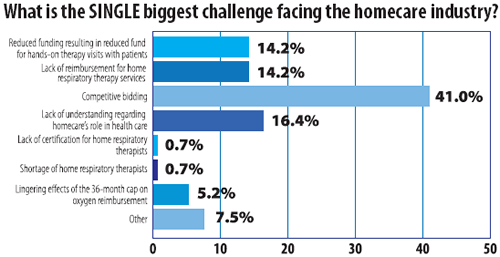
Overall, the payment reduction for the oxygen category (which includes numerous HCPCS codes) is approximately a 40-percent reduction off the 2013 Medicare fee schedules, according to Joe Lewarski, vice president of Clinical Affairs for Invacare Corp. It’s no wonder competitive bidding remains a significant concern.
Who Took the Survey?
Respondents come from all over the United States, with this year’s most represented region being the Midwest (31.8 percent of respondents), followed by the East (28 percent), the South (27.6 percent) and the West (13.6 percent). Of the survey takers, just over 80 percent have 15 years or more experience as respiratory therapists, 56.1 percent have RRT certification, 43.1 have CRT certification and less than 2 percent hold AE-C certification.
- 28.6 percent devote from 10 percent to 25 percent of their time to oxygen therapy while only 2.5 percent spend over 90 percent
- 28.3 percent devote from 50 percent to 75 percent on sleep therapy while only 9.2 percent spend over 90 percent
- 46.7 percent spend less than 10 percent on asthma therapy, while 44.9 percent devote no time to ventilation therapy
- 91.5 percent either recommend or approve products for their company
- 59.5 percent have 15 years or more experience as a respiratory therapist in the homecare setting
Competitive Bidding Round Two
Regarding Round Two of competitive bidding, 42.1 percent of respondents were located in a Round Two bidding areas, 14.8 percent of all respondents were located in Round One bidding areas, and 49.3 percent were not located in a competitive bidding area. Of all respondents located in a Round Two bidding area, 19.5 percent hold a contract for oxygen, while 11.4 percent hold a contract for sleep. About 6.3 percent hold a Round One contract for oxygen and 4.1 percent hold a Round One contract for sleep.
(From last year’s survey: For Round Two, 61.9 percent of respondents said they bid for oxygen services and 60.6 percent bid for sleep services. The majority of Round Two bidders — 39.5 percent — said they were somewhat confident that they would win a contract. Only 2.6 percent said they were extremely confident, where 22.4 percent said they were not confident at all.)
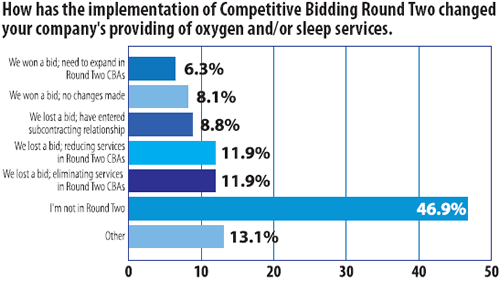
For a provider not located in a Round Two bidding area, the effects of lower reimbursement are rippling throughout the industry.
“I’m not in Round Two, but its reimbursement levels have affected other payers,” a survey respondent noted. “Primarily private at this time, although I expect Medicaid Managed Care organizations will follow suit shortly.”
To counter the cuts from Round Two, 8.8 percent of respondents that lost a Round Two bid have entered into a subcontracting relationship. In aggregate, however, 71.8 percent of respondents do not believe that subcontracting is a feasible option for oxygen providers that didn’t win Round Two contracts. For sleep subcontracting, 67.5 percent of respondents thought subcontracting wasn’t feasible. Other contingency plans that providers have implemented because of Round Two include:
- Reducing clinical areas and expanding into more private pay areas
- Expanding the retail side of business
- Seeking and obtaining more PPO network contacts and developing a disease management program
- Focusing on non-Medicare payers and products
- Ramping up repair services for complex rehab equipment
- Cutting office space to reduce rent costs
- Reducing more costly product lines
- Laying off employees and changing the marketing strategy
- Shifting target audience to 30- to 65-year-old age groups
- Marketing to referral sources for private payers
- Moving the business outside the current location
- Ramping up efforts with HST to help grow the sleep business
- Eliminating on-demand tank deliveries and requiring pick-up in store
- Looking for acquisitions
“Only a small portion of our service area is located in a Round Two area but we grandfathered our existing patients in that area,” another provider replied. “We are evaluating all business activity to see what we can modify to save money for the next rounds.”
Although many providers and provider organizations are working on alternatives to competitive bidding, such as the Market Pricing Program (MPP), which was introduced in Congress as HR 1717 and currently has 165 co-sponsors, 49.1 percent of respondents say it is not likely that the industry will be able to stop competitive bidding, either through repeal or replacing it with the MPP. Another 10.7 percent feel competitive bidding is in place and cannot be stopped, while 8.8 percent said the industry is gaining enough momentum to stop it.
“We are too easy a target,” a respondent stated. “New patients don’t know what bad service is because they haven’t experienced Medicare yet and all the old patients were grandfathered in. They won and we and the patients have all lost.”
Another respondent is frustrated that providers are not recognized for the education and efforts they contribute to keep patients’ compliant, in the home and out of the hospital, and feels DME should be allowed to provide a billable service for this time and effort spent.
Many of the comments that respondents contributed discuss concern for patients, who they feel will ultimately be the biggest casualties of the competitive bidding war. Over 55 percent of respondents said they have reduced the frequency of in-person therapist follow-up visits as a result of industry-wide reimbursement cuts. Other provider cuts include eliminating in-person therapist follow-up visits (21 percent), reducing the frequency of telephone therapist follow-up (12.6 percent) and eliminating telephone therapist follow-up (5.9 percent).
“The future of healthcare lies in the home and community,” a respondent explained. “Clinicians have historically not concerned themselves with reimbursement issues. While maintaining patient advocacy, we must recognize the reality that reimbursement has and will be the driving force that decides what equipment the patient can receive. As audits increase, respiratory care practitioners with reimbursement knowledge can be a valuable resource for organizations responding to audits and to payers initiating audits.”
More on Patient Care
While business must continue, so must providers’ goal of giving the best healthcare possible under competitive bidding. To address or improve patient compliance, 87.8 percent of respondents said they are making follow-up calls to patients while 55.3 percent are making follow-up visits to patients’ homes. Other strategies employed by respondents include the use of modems for PEP patients, communicating with physicians and other providers, educating the patient about OSA and COPD, becoming a member of the readmission committee at local hospitals, and using surveillance equipment for compliance.
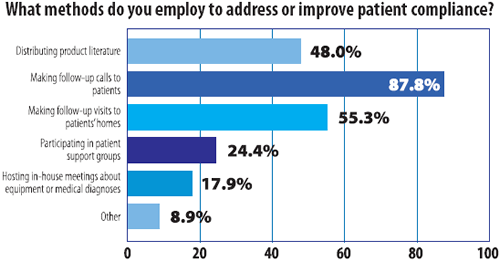
The majority of respondents (41 percent) named bulky/burdensome equipment as the primary barrier to patient compliance for oxygen therapy and difficulty with masks or interfaces (70.2 percent) as the primary barrier to patient compliance for sleep therapy.
One respondent stated that patients expecting instant results instead of allowing themselves time to adjust and work with the provider is another barrier to compliance.
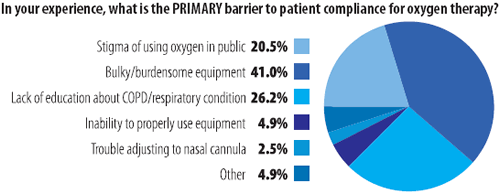
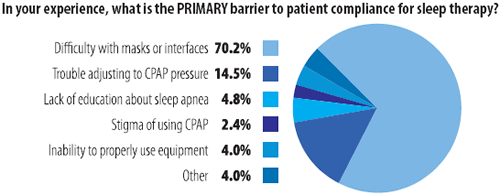
Just over 44 percent of respondents have responded to reimbursement cuts by reducing the frequency of oxygen deliveries. Survey takers are also:
- Transitioning to non-delivery models (39 percent)
- Using home transfilling systems (32.3 percent)
- Using portable oxygen concentrators (28 percent)
- Reducing oxygen delivery staff (24.6 percent)
Reduced reimbursement has also changed how most respondents approach clinical services for patients. Over half of all respondents (55.5 percent) said they have reduced the frequency of in-person therapist follow-up visits, while 20.3 percent report making no changes.
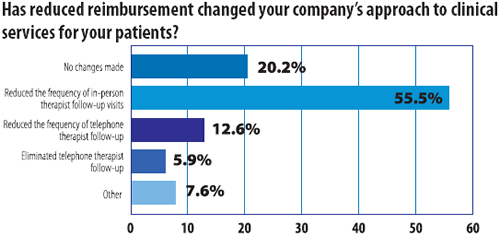
An industry in flux
So how has the job changed over the last 12 months? For some it’s been more of the same and for others it’s been an increasingly more difficult dance. One provider reports that they are maintaining top clinical services with a decrease in their patient population. Providers seem to be working longer hours but are frustrated by the increase in paperwork, which has taken time away from patients and preventative services. Some see that as reimbursement increases, RT services decrease, but there is some hope of a comeback with COPD readmission programs. Once respondent sums it up this way:
“Before I got into home respiratory, I had jobs in several different fields,” a respondent noted. “I never had a job that gave me the personal satisfaction I have had doing this. However, the recent interference in healthcare by the federal government has made respiratory services providers the enemies of the patients and the doctors. It has become much harder for me to enjoy my work.”
This article originally appeared in the March 2014 Respiratory & Sleep Management issue of HME Business.